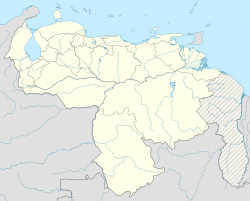Caripito facts for kids
Quick facts for kids
Caripito
|
|
|---|---|
Caripito is a city in the Monagas state of Venezuela. About 50,000 people live there. It's the third-largest city in Monagas, after Maturín and Punta de Mata.
Contents
The Story of Caripito
Caripito was first a small mission town. But a big fire destroyed it on March 17, 1783. So, that first settlement didn't last long.
Over time, Caripito had many names. These included La Palencia, San Juan, and Caripe Horno. Finally, it became Caripito, which is a smaller version of the nearby town Caripe. In 1896, Caripito officially became part of the Colón municipality. This gave it political recognition.
Oil Brings Growth
In 1910, the first school opened in Caripito. Then, in 1924, the Standard Oil Company started looking for oil nearby. This brought more people to the area.
When oil drilling began in 1928, Caripito grew a lot. Many workers moved there, especially from the Caribbean islands. In 1929, Standard Oil built a storage area and a deep-water pier on the San Juan River. On October 15, 1930, the first oil tanker left the port. It carried 20,000 barrels of oil to Trinidad.
City Development
More services helped the city grow even faster. These included modern health services and hotels. There were also power plants, better transport, and schools. An airport and a military base were also built. Many families moved to Caripito. They came from Venezuelan states like Sucre and Nueva Esparta. People also came from the United States and the Caribbean.
In 1931, the Standard Oil Company opened an oil refinery in Caripito. It could process 26,000 barrels of oil each day. This was the second refinery of its kind in Venezuela.
Caripito's Airport and Amelia Earhart
In 1935, a terminal for Pan Am seaplanes opened on the San Juan River. These planes could arrive from Central America and the Caribbean.
A famous event happened in 1936. The pilot Amelia Earhart chose Caripito International Airport. It was her second stop on her trip around the world. She stayed at the Standard Oil Company facilities. News of her visit spread worldwide. The company helped her continue her flight through South America.
Oil Production and Changes
In 1938, the Creole Petroleum Corporation made the Caripito refinery bigger. It could then process 70,000 barrels of oil daily. This made it the most important refinery in Venezuela for a while. Later, bigger refineries were built elsewhere.
Caripito became the capital of the Bolívar District in 1940. Between 1941 and 1961, Caripito's population doubled. This was because of all the oil work. But by the mid-1970s, oil production slowed down. About a third of the people moved away.
In 1976, the government took over Creole's oil operations. They were managed by different companies over time. These included Lagoven, Corpoven, and now PDVSA. The refinery closed in 1976, and the oil terminal closed in 2002. Since then, people have tried to boost farming in the area. This is because the land is very fertile.
Places to Visit
- Iglesia Sagrado Corazón de Jesús (Church of the Sacred Heart of Jesus): This church was built in 1936.
- Monumento al Nazareno (Monument to the Nazarene): This monument was built in 2005. It is a tall statue of the Nazarene, standing 20 meters high.
Images for kids
See also
 In Spanish: Caripito para niños
In Spanish: Caripito para niños




